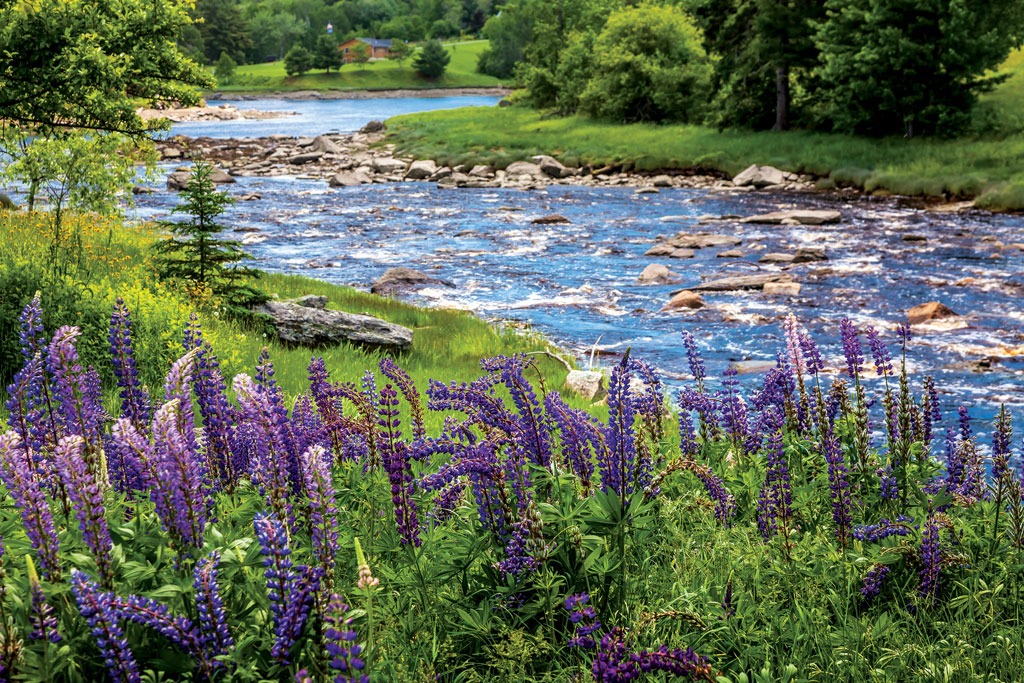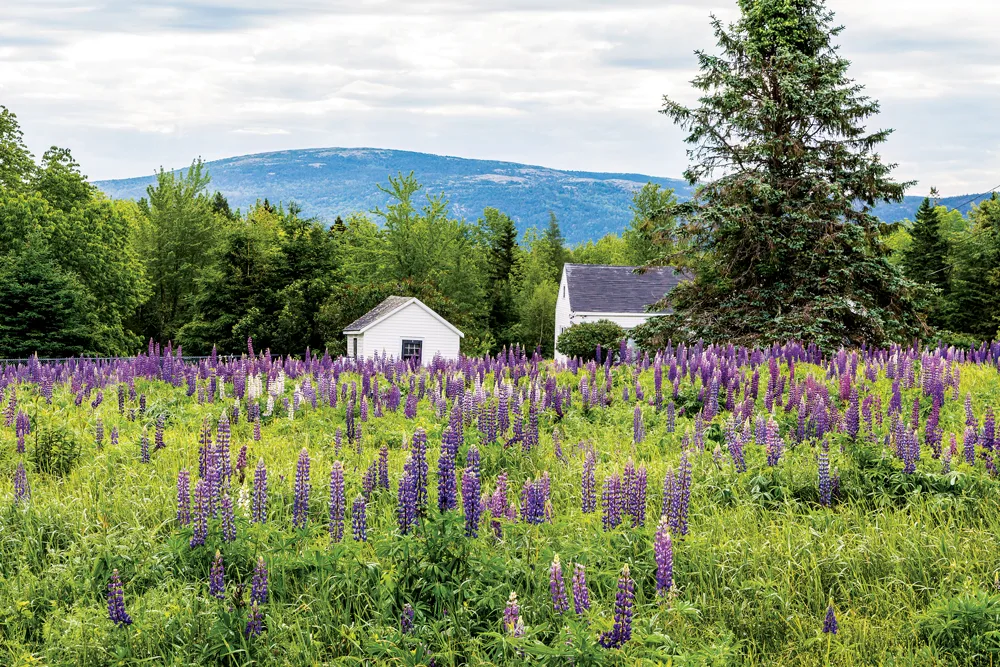By Richard Grant
Photos by Susan Cole Kelly
From our June 2014 issue
In a state where summer is famously unpredictable, you can bet on one thing: every road and hillside and meadow worth its salt from Kittery to Caribou will be aglow with purple spires in mid-June — the ramp-up to the summer solstice — when lupines come into flower.
During the two weeks or so when the great lupine show is going on, you’ll probably feel like so many Mainers that this splendid creature deserves to be the Maine state flower, no question. It has every virtue, even apart from the dusky beauty of its blooms. It’s fragrant: sweet with a spicy, peppery edge. It’s tough, thriving in poor, sandy soil and indifferent to environmental insults like drought, insects, and disease. It’s variable enough to avoid monotony — ranging naturally from purple to white, pink, and a bright rosy hue just short of red — but these colors never clash and can even seem tastefully understated compared to, say, the glare of gladioli and geraniums.
Lupines are so much a part of the Maine scene that it’s startling to realize they haven’t always been here. The late Barbara Cooney, author of the children’s classic Miss Rumphius — the tale of the Lupine Lady who scattered seeds everywhere she went — recalled that in her girlhood lupines were not the ubiquitous roadside attraction we know today. “I remember when you first started seeing them, out in fields,” she said. “And that wasn’t that long ago.”
Clearly there’s more to this story than meets the eye.

As with many great characters, in nature as on stage, lupines have a rougher and wilder side. It makes them more interesting, I think, though it probably nixes them as candidates for state flower (which is, if you’re wondering, the white pine cone and tassel). For starters, their parentage is dubious. The flowers we see are not pure New England natives, though they may have acquired some native blood by crossing with their local cousins, Lupinus perennis, which are hard to find in Maine now. Their main ancestry is a species called Lupinus polyphyllus, which in its original West Coast habitat can grow 5 feet tall. There may be a European connection, via colonists who valued lupine as a food crop. (It’s a member of the pea family, as you can tell by inspecting its pods, and its seeds are said to have four times the protein content of whole wheat.)
The lupine’s wilder side is embedded in its name: lupinus is Latin for “wolf,” and “wolf flower” is still the common name in Dutch and other languages. No one seems to know why. One 19th-century authority suggests that the Romans accorded this title after finding that lupines “ravaged the soil.” There was also a widespread idea that lupines, like wolves, are deadly to livestock. (Some species do indeed produce toxins.)
And what, pray tell, are we to make of this strange connection between lupines and the underworld, recorded by Browning in his narrative poem “Pippa Passes”?

As some Greek dog-sage, dead and merry, / Hellward bound in Charon’s wherry / With food for both worlds, under and upper, / Lupine-seed and Hecate’s supper, / And never an obolus.
Never an obolus when you need one! (It’s a silver coin, presumably to pay the ferryman.) But there you go: something to think about while you’re cruising our lovely byways ogling Flora in her altogether. Or waiting for the ferry, come to that.
Given the glory of lupines and their evident ease of cultivation, you may be tempted to bring them into your garden. You’ll have no trouble finding well-bred seed stock, including the Russell strain that originated in England but is based on North American parentage. Or you can gather seeds from mature plants in the wild. Timing is everything here: the pods break open as they dry, so you have to catch the seeds before they spill. It’s better to start from seed, by the way, than to look for plants at the garden center. Lupines develop long, fragile taproots, which makes them ill suited for pots and difficult to transplant.
Still, you might take pause before pursuing any of this. I’ve done it, and I can tell you how it goes. First the seeds, which are large and easy to handle, sprout as readily as radishes. The baby plants are adorable, forming mounds of five-part radial leaves that look intriguingly exotic. These mounds expand quickly, growing wider than they are tall, which tends to require more space than you’ve allowed for. But no matter: in due course, which may be next summer if you’ve gotten a late start, the flower stalk appears and now you can see what’s in store for you.
More likely than not, in my experience, the same lupines that look splendid in an old field become gangly and weak-kneed in a garden. The soil is too rich, you’re fussing over them too much, the maple casts more shade than you thought it would . . . or something. There’s usually something. But let’s say there’s not — you’ve properly starved and neglected these plants in the harshest of sunlight. You’ll be rewarded with beautiful blooms. Which will seem sparse, even stingy, in relation to the overall mass of the thing. Because you planted too few of them, probably, and lupines, like wolves, do better in packs. But since we’re pretending, let’s say you planted dozens of lupines in a horrible place and then ignored them: Congratulations! You have a wonderful show.
Enjoy it while you can; what follows is ghastly. The moment they’re done blooming, lupines get on with the business of reproducing and dying. Some may limp on for another year, especially if you deadhead the stalks, but in general they’re monocarpic, flowering only once. As they perish, they blacken and shrivel, leaving a large patch of lifeless ground littered with ugly detritus. The greater the show, the more desolate the aftermath. Is this what you want to look at in August?

Lupines belong where we find them, I think: all up and down Maine’s roadsides, where they can take their place in a succession of wild things, starting with pale green grass and buttercups, extending through yellowing grass and black-eyed Susans, culminating in asters and seed stalks. Some acts of this yearly drama are more vibrant and colorful than others. Lupines may be the most flamboyant players in the cast. But they need the right sort of stage to strut their stuff.
Just when and why lupines came to Maine, and how they spread themselves all over the state, remains somewhat mysterious. But it’s a pleasant mystery, enjoyable to contemplate, in an age when we often seem to know too much about too many things. I like to imagine that lupines chose Maine as a place to settle, as many of us more mobile creatures have done, and got here by whatever means were convenient at the time. Maybe the Lupine Lady brought them, by way of making the world more beautiful. I can believe that.




